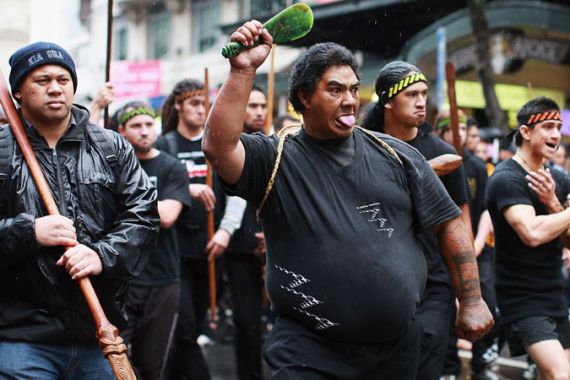Racism: Tolerated and trivialised in New Zealand
Indigenous groups seek to fight back against stereotypes being pushed in mainstream media.

As covered recently by Al Jazeera, New Zealand holds a harsh colonial history that has resulted in stark social disparities falling along racial lines. As in other neocolonial states, it is New Zealand’s indigenous Maori population that suffers the brunt of social inequality.
Official governmental agencies keep regular tabs on Maori residents’ social trends, noting a variety of concerns. Relative to the general population, Maori typically show higher rates of unemployment, obesity, and incarceration, lower rates of educational achievement, and poorer access to health care.
New Zealand, however, is very much a multicultural place. Along with the indigenous Maori and majority Caucasian populations reside a range of settler groups that include diverse Pacific residents from the Cook Islands, Fiji, Niue, Samoa, and Tonga, among other places. Notably, most of these countries share similar colonial histories with New Zealand. And perhaps unsurprisingly, residents who trace their ancestry to other parts of the Pacific now residing in New Zealand share social circumstances that are comparable with Maori with respect to health care, unemployment and education.
Politicians, pundits, and academics provide an array of explanations for these racialised trends. But many Maori and Pacific residents are breaking them – excelling educationally, exemplifying healthy living, and contributing to New Zealand society as model citizens.
 |
| Traditional acts such as hikoi and haka, which often involve fierce facial expressions, are often labelled as ‘primitive’ by media figures [GALLO/GETTY] |
But breaking these trends is made all the more difficult when mainstream media presents the trends as social norms. Last month, award-winning cartoonist Al Nisbet penned two satirical pieces on New Zealand’s free breakfast programme for schoolchildren in lower decile schools.
The two pieces, published on May 29 and 30 in the Marlborough Express and The Press, respectively, portray characters that play into mainstream stereotypes of Maori and Pacific peoples. Selected characters are shaded in a brownish hue, presented as overweight, speaking improper English, belching, and expressing their value for government subsidies so they can spend money on wasteful activities, also portrayed in the cartoons: drinking alcohol, smoking cigarettes, and gambling.
Despite understandable outrage from some New Zealand residents regarding the cartoons’ racialised overtones, Nisbet refuses to apologise, arguing that the cartoons also include Caucasian characters. Nisbet’s lines of defence, however, fail to acknowledge that the more central characters in the cartoons who belch, are overweight, and in one case smoke a cigarette, are clearly shaded brown.
Of critical importance, Nisbet is neither Maori nor Pacific. University of Auckland students of Maori and Pacific descent are angered by the cartoons. Fapiola Siale, a criminology major, said: “As a Tongan university student, it only angers me looking at these cartoons… These cartoons play into the whole stereotype that Pacific Islanders are uneducated and that we are all spending on unimportant items. It is simply not funny to make a joke out of the struggles people face.”
Public support and governmental complacency
But it is not just Nisbet who believes the cartoons are an acceptable part of popular and political culture. Marlborough Express editor Steve Mason claims that although the paper has received complaints, the cartoons have also garnered public support. And then there is governmental leadership that refuses to seriously intervene. New Zealand’s Race Relations Commissioner, Susan Devoy, states that although the cartoons are offensive, they do not exceed a racism threshold established by the Human Rights Commission. Even New Zealand’s Prime Minister, John Key, chimed in, arguing that the racism threshold should not be changed because, like pornography, racism is subjectively defined.
These reactions are not entirely surprising. Jay Tausi, a part-Samoan law and sociology postgraduate student at the University of Auckland, explained how the cartoons skirt governmental involvement and perpetuate public racism via humour: “These cartoons pretty much reflect how most New Zealanders perceive the state of Maori and Pacific people at the moment. And by using cartoons, it enables the stereotypical messages to be conveyed in a more digestible and perceivably less racist manner.”
The pathetic reliance on racist tropes in the cartoons and the cowardly response of those in power is the latest tragic illustration of a divided, uninformed society... Witnessing the feeble discussions regarding a 'racism threshold' led by an incompetent and ill-equipped race relations commissioner is nauseating
Emerald McPhee, a Maori student majoring in English and psychology, added: “It’s saddening, frustrating and aggravating – yet unsurprising – to see the majority attitude completely denies the existence of racism both in these cartoon pieces and in general New Zealand society.”
Tausi went on to note that the cartoons decontextualise social inequality and “divert attention away from what needs immediate resolution, namely child poverty, by instead focusing on Maori and Pacific parents as if they’re entirely responsible for their situation… Cartoons like this simply feed general ignorance.”
This is a perspective echoed by Juliet Perano, a Caucasian postgraduate sociology student who stated: “The pathetic reliance on racist tropes in the cartoons and the cowardly response of those in power is the latest tragic illustration of a divided, uninformed society… Witnessing the feeble discussions regarding a ‘racism threshold’ led by an incompetent and ill-equipped race relations commissioner is nauseating.”
Colonialism continued
The cartoons and the support they have received from segments of New Zealand society do not exist in a contemporary political vacuum. A reading of colonial media from the 19th and 20th centuries shows gazettes and missionary articles portraying Maori natives as uncivilised and barbaric, which was very far from the truth.
These cartoons and the public support they receive are merely an extension of past conceptions of Maori and Pacific peoples in the consciousness of mainstream New Zealand. As this case illustrates, mainstream media and a lack of governmental intervention in the face of racism make Maori and Pacific peoples easier targets for victim blaming and Euro-centric superiority.
Of course, Maori and Pacific Islander resistance to racism demonstrates that passive victimisation is not a typical response. As undergraduate student Fapiola Siale said: “The editor should’ve never published this. It is this kind of racism that motivates me and other Pacific Islanders to be successful in life.”
Still, the New Zealand government and mainstream media should do away with racist texts, so Maori and Pacific peoples can find motivation unburdened by ongoing racism.
David Mayeda is a lecturer at The University of Auckland in the Department of Sociology. He also blogs at SociologyInFocus and TheCrankySociologists.
Patti Sobieski (Ngapuhi, Te Aupouri & Te Arawa) is a Maori postgraduate student of theology at the University of Auckland with a major in Biblical Studies and a minor in Public Theology.